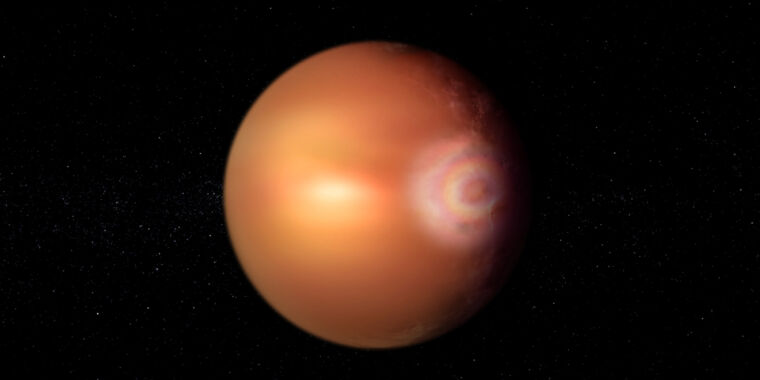Glow of an exoplanet may be from starlight reflecting off liquid iron
For all the glory —
A phenomenon called a “glory” may be happening on a hellishly hot giant planet.

Enlarge / Artist impression of a glory on exoplanet WASP-76b.
Do rainbows exist on distant worlds? Many phenomena that happen on Earth—such as rain, hurricanes, and auroras—also occur on other planets in our Solar System if the conditions are right. Now we have evidence from outside our Solar System that one particularly strange exoplanet might even be displaying something close to a rainbow.
Appearing in the sky as a halo of colors, a phenomenon called a “glory” occurs when light hits clouds made up of a homogeneous substance in the form of spherical droplets. It might be the explanation for a mystery regarding observations of exoplanet WASP-76B. This planet, a scorching gas giant that experiences molten iron rain, has also been observed to have more light on its eastern terminator (a line used to separate the day side from the night side) than its western terminator. Why was there more light on one side of the planet?
After observing it with the CHEOPS space telescope, then combining that with previous observations from Hubble, Spitzer, and TESS, a team of researchers from ESA and the University of Bern in Switzerland now think that the most likely reason for the extra light is a glory.
Seeing the light
Over three years, CHEOPS made 23 observations of WASP-76B in both visible and infrared light. These included phase curves, transits, and secondary eclipses. Phase curves are continuous observations that track a planet’s complete revolution and show changes in its phase or the part of its illuminated side that is facing the telescope. The telescope may see more or less of that side as the planet orbits its star. Phase curves can determine the change in the total brightness of the planet and star as the planet orbits.
Secondary eclipses happen when a planet passes behind its host star and is eclipsed by it. The light seen during such an eclipse can later be compared with the total light both before and after the occultation to give us a sense of the light that’s reflected off the planet. Hot Jupiters like WASP-76B are commonly observed through secondary eclipses.
Phase-curve observations can continue while the planet is eclipsing its star. While it was observing the phase curve of WASP-76B, CHEOPS saw a pre-eclipse excess of light on its night side. This had also been seen in TESS phase-curve and secondary-eclipse observations that had been made earlier.
End of the rainbow?
An advantage of WASP-76b is that it is an ultra-hot Jupiter, so at least its day side does not have the clouds and hazes that often obscure the atmospheres of cooler hot Jupiters. This makes atmospheric emissions much easier to detect. That we had already observed an asymmetry in iron content between the day-side and night-side terminators, discovered in a previous study, made the planet especially intriguing. There was not much gaseous iron in the upper atmosphere of the day-side limb compared to that of the night-side limb. This is probably because it rains iron on the day side of WASP-76b, which then condenses into clouds of iron on the night side.
Observations from Hubble suggested that thermal inversion—when the air near the surface of a planet begins cooling—was occurring on the night side. Cooling on that side would cause iron that had previously condensed into clouds, rained down onto the day side, and then evaporated from the intense heat to condense again. Drops of liquid iron can then form clouds.
These clouds are critical since light from the host star, reflecting off these drops in those clouds, can create the effect of a glory.
“Explaining the observation with the glory effect would require spherical droplets of highly reflective, spherically shaped aerosols and clouds on the planet’s eastern hemisphere,” the researchers said in a paper recently published in Astronomy & Astrophysics.
Glories have been seen off Earth before. They are also known to form in the clouds of Venus. Just like WASP-76b, more pre-eclipse light was observed on Venus, so while a glory is all but definite for the exoplanet, future observations with a more powerful telescope could help determine how similar the phenomenon on WASP-76 is to that on Venus. If they match, this will be the first glory ever observed on an exoplanet.
If future research figures out a definite way to tell whether this is really a glory, these phenomena could tell us more about the atmospheric makeup of exoplanets, depending on the kinds of elements or molecules light is reflecting off of. They might even give away the presence of water, which could mean habitability. While the hypothesized glory on WASP-76b has not been definitively demonstrated, it is anything but a rainbow in the dark.
Astronomy & Astrophysics, 2024. DOI: 10.1051/0004-6361/202348270
Glow of an exoplanet may be from starlight reflecting off liquid iron Read More »
